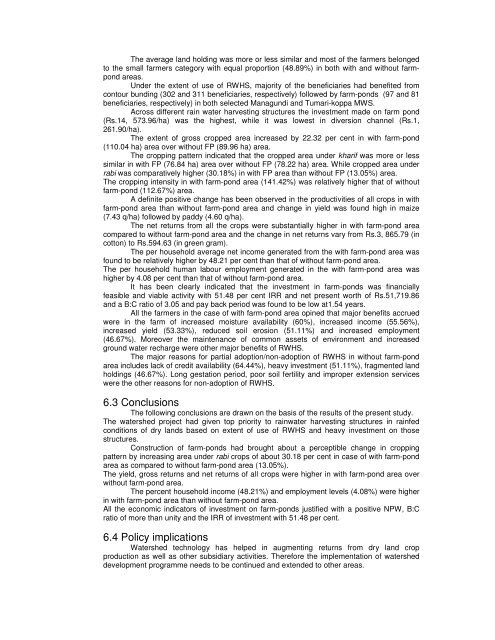Master of Science - ETD | Electronic Theses and Dissertations of ...
Master of Science - ETD | Electronic Theses and Dissertations of ...
Master of Science - ETD | Electronic Theses and Dissertations of ...
You also want an ePaper? Increase the reach of your titles
YUMPU automatically turns print PDFs into web optimized ePapers that Google loves.
The average l<strong>and</strong> holding was more or less similar <strong>and</strong> most <strong>of</strong> the farmers belonged<br />
to the small farmers category with equal proportion (48.89%) in both with <strong>and</strong> without farmpond<br />
areas.<br />
Under the extent <strong>of</strong> use <strong>of</strong> RWHS, majority <strong>of</strong> the beneficiaries had benefited from<br />
contour bunding (302 <strong>and</strong> 311 beneficiaries, respectively) followed by farm-ponds (97 <strong>and</strong> 81<br />
beneficiaries, respectively) in both selected Managundi <strong>and</strong> Tumari-koppa MWS.<br />
Across different rain water harvesting structures the investment made on farm pond<br />
(Rs.14, 573.96/ha) was the highest, while it was lowest in diversion channel (Rs.1,<br />
261.90/ha).<br />
The extent <strong>of</strong> gross cropped area increased by 22.32 per cent in with farm-pond<br />
(110.04 ha) area over without FP (89.96 ha) area.<br />
The cropping pattern indicated that the cropped area under kharif was more or less<br />
similar in with FP (76.84 ha) area over without FP (78.22 ha) area. While cropped area under<br />
rabi was comparatively higher (30.18%) in with FP area than without FP (13.05%) area.<br />
The cropping intensity in with farm-pond area (141.42%) was relatively higher that <strong>of</strong> without<br />
farm-pond (112.67%) area.<br />
A definite positive change has been observed in the productivities <strong>of</strong> all crops in with<br />
farm-pond area than without farm-pond area <strong>and</strong> change in yield was found high in maize<br />
(7.43 q/ha) followed by paddy (4.60 q/ha).<br />
The net returns from all the crops were substantially higher in with farm-pond area<br />
compared to without farm-pond area <strong>and</strong> the change in net returns vary from Rs.3, 865.79 (in<br />
cotton) to Rs.594.63 (in green gram).<br />
The per household average net income generated from the with farm-pond area was<br />
found to be relatively higher by 48.21 per cent than that <strong>of</strong> without farm-pond area.<br />
The per household human labour employment generated in the with farm-pond area was<br />
higher by 4.08 per cent than that <strong>of</strong> without farm-pond area.<br />
It has been clearly indicated that the investment in farm-ponds was financially<br />
feasible <strong>and</strong> viable activity with 51.48 per cent IRR <strong>and</strong> net present worth <strong>of</strong> Rs.51,719.86<br />
<strong>and</strong> a B:C ratio <strong>of</strong> 3.05 <strong>and</strong> pay back period was found to be low at1.54 years.<br />
All the farmers in the case <strong>of</strong> with farm-pond area opined that major benefits accrued<br />
were in the farm <strong>of</strong> increased moisture availability (60%), increased income (55.56%),<br />
increased yield (53.33%), reduced soil erosion (51.11%) <strong>and</strong> increased employment<br />
(46.67%). Moreover the maintenance <strong>of</strong> common assets <strong>of</strong> environment <strong>and</strong> increased<br />
ground water recharge were other major benefits <strong>of</strong> RWHS.<br />
The major reasons for partial adoption/non-adoption <strong>of</strong> RWHS in without farm-pond<br />
area includes lack <strong>of</strong> credit availability (64.44%), heavy investment (51.11%), fragmented l<strong>and</strong><br />
holdings (46.67%). Long gestation period, poor soil fertility <strong>and</strong> improper extension services<br />
were the other reasons for non-adoption <strong>of</strong> RWHS.<br />
6.3 Conclusions<br />
The following conclusions are drawn on the basis <strong>of</strong> the results <strong>of</strong> the present study.<br />
The watershed project had given top priority to rainwater harvesting structures in rainfed<br />
conditions <strong>of</strong> dry l<strong>and</strong>s based on extent <strong>of</strong> use <strong>of</strong> RWHS <strong>and</strong> heavy investment on those<br />
structures.<br />
Construction <strong>of</strong> farm-ponds had brought about a perceptible change in cropping<br />
pattern by increasing area under rabi crops <strong>of</strong> about 30.18 per cent in case <strong>of</strong> with farm-pond<br />
area as compared to without farm-pond area (13.05%).<br />
The yield, gross returns <strong>and</strong> net returns <strong>of</strong> all crops were higher in with farm-pond area over<br />
without farm-pond area.<br />
The percent household income (48.21%) <strong>and</strong> employment levels (4.08%) were higher<br />
in with farm-pond area than without farm-pond area.<br />
All the economic indicators <strong>of</strong> investment on farm-ponds justified with a positive NPW, B:C<br />
ratio <strong>of</strong> more than unity <strong>and</strong> the IRR <strong>of</strong> investment with 51.48 per cent.<br />
6.4 Policy implications<br />
Watershed technology has helped in augmenting returns from dry l<strong>and</strong> crop<br />
production as well as other subsidiary activities. Therefore the implementation <strong>of</strong> watershed<br />
development programme needs to be continued <strong>and</strong> extended to other areas.
















